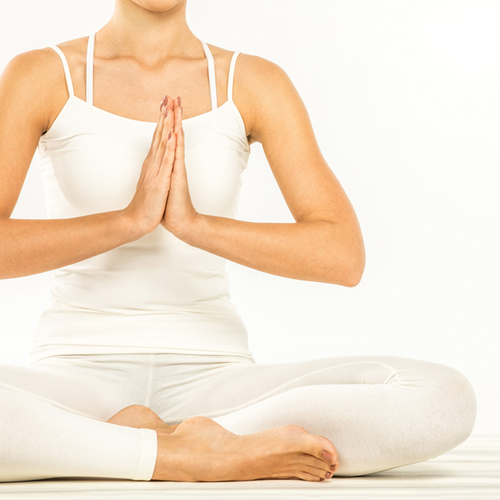
Background
Kundalini yoga is a specific type of yoga practice that combines physical poses with controlled breathing, chanting (mantras), meditations, prayer, visualizations, and guided relaxation (99759).
People use this for...
Safety Safety definitions
Possibly Safe ...when used appropriately. Kundalini yoga has been practiced in clinical trials with apparent safety. No serious adverse events have been reported (28412,28413,28414,28415,88992, 99761). However, there is some concern that Kundalini yoga might not be safe for all patients. Kundalini yoga involves breathing and meditation practices that are more intense than other forms of yoga, and most studies have not conducted a high-quality evaluation of safety outcomes.
Pregnancy And Lactation: There is insufficient reliable evidence about the safety of Kundalini yoga use in women that are pregnant or lactating; avoid using.
Effectiveness Effectiveness definitions
POSSIBLY EFFECTIVE
Obsessive-compulsive disorder (OCD). Some clinical research shows that performing Kundalini yoga for 2 hours once weekly for 3 months may help reduce symptoms of OCD compared to practicing relaxation response and mindfulness meditation (28415). Other preliminary clinical research shows that practicing movement and breathing techniques of Kundalini yoga for 5-6 months may decrease symptoms of OCD and the need for medication (88992).
POSSIBLY INEFFECTIVEHypertension. Clinical research in patients with hypertension shows that practicing a type of Kundalini yoga called Mediyoga does not reduce blood pressure when compared with control (99761).
INSUFFICIENT RELIABLE EVIDENCE TO RATECognitive function. Preliminary clinical research in healthy patients shows that using the Kundalini yoga technique of one nostril breathing may improve cognitive performance (28412,28413).
Cognitive impairment. A small clinical study in patients with mild cognitive impairment shows that practicing Kundalini yoga for 12 weeks seems to improve memory and thinking skills about as effectively as following a memory enhancement training program, which is considered to be a gold standard (99759).
Depression. Preliminary clinical research in patients with depression shows that practicing Kundalini yoga for 1 hour before breakfast for 6 months may improve symptoms of depression (28414).
More evidence is needed to rate Kundalini yoga for these uses.
Natural Medicines rates effectiveness based on scientific evidence according to the following scale: Effective, Likely Effective, Possibly Effective, Possibly Ineffective, Likely Ineffective, Ineffective, and Insufficient Evidence to Rate.
Dosing & administration
Interactions with pharmaceuticals
None known.
Interactions with herbs & supplements
None known.
Interactions with foods
None known.
Interactions with lab tests
Interactions with diseases
Mechanism of action
Kundalini yoga is an ancient Indian practice. It involves several techniques such as controlled breathing, meditation, and specific body postures (99761). The controlled breathing used in Kundalini yoga can be rapid or slow. Ancient texts describe rapid breathing as being cleansing and stimulating, while the slow breathing, particularly through alternate nostrils, is thought to be calming (28417).
Along with controlled breathing, Kundalini yoga incorporates many practices used in other traditions of yoga. Thus, the body of yoga research as a whole provides general support for Kundalini yoga. Kundalini and other forms of yoga are thought to alter excitation and inhibition in the brain, habituation of reflexes, and homeostasis (28418).
In theory, physical and mental stress that is continued for prolonged periods may result in overstimulation of the sympathetic nervous system. Symptoms of this are thought to be a gradual rise in blood pressure and heart rate, increased metabolism, and disturbances of the endocrine system. Meditation and yoga, such as Kundalini yoga, may gradually diminish sympathetic overstimulation and bring the nervous system back into equilibrium (28419).
References
| 28412 | Shannahoff-Khalsa, D. S., Boyle, M. R., and Buebel, M. E. The effects of unilateral forced nostril breathing on cognition. Int J Neurosci 1991;57(3-4):239-249. View abstract. |
| 28413 | Jella, S. A. and Shannahoff-Khalsa, D. S. The effects of unilateral forced nostril breathing on cognitive performance. Int J Neurosci 1993;73(1-2):61-68. View abstract. |
| 28414 | Devi S, Chansouria JP, Malhotra OP, and et al. Certain neuroendocrine responses following the practice of Kundalini yoga. Alternative Medicine 1986;1(3):247-255. |
| 28415 | Shannahoff-Khalsa DS, Ray LE, Levine S, and et al. Randomized controlled trial of yogic meditation techniques for patients with obsessive-compulsive disorder. CNS Spectr 1999;4(12):34-47. View abstract. |
| 28417 | Raghuraj P, Ramakrishnan AG, and Nagendra HR, et al. Effect of two selected yogic breathing techniques of heart rate variability. Indian J Physiol Pharmacol 1998;42(4):467-472. |
| 28418 | Dostálek C. Physiological bases of yoga techniques in the prevention of diseases. Homeostasis 1994;35(4-5):205-208. |
| 28419 | Anand, B. K. Yoga and medical sciences. Indian J Physiol Pharmacol 1991;35(2):84-87. View abstract. |
| 88992 | Shannahoff-Khalsa, D. S. and Beckett, L. R. Clinical case report: efficacy of yogic techniques in the treatment of obsessive compulsive disorders. Int J Neurosci 1996;85(1-2):1-17. View abstract. |
| 99759 | Eyre HA, Siddarth P, Acevedo B, et al. A randomized controlled trial of Kundalini yoga in mild cognitive impairment. Int Psychogeriatr. 2017;29(4):557-567. View abstract. |
| 99760 | Khalsa SB, Khalsa GS, Khalsa HK, Khalsa MK. Evaluation of a residential Kundalini yoga lifestyle pilot program for addiction in India. J Ethn Subst Abuse. 2008;7(1):67-79. View abstract. |
| 99761 | Wolff M, Rogers K, Erdal B, Chalmers JP, Sundquist K, Midlöv P. Impact of a short home-based yoga programme on blood pressure in patients with hypertension: a randomized controlled trial in primary care. J Hum Hypertens. 2016;30(10):599-605. View abstract. |




